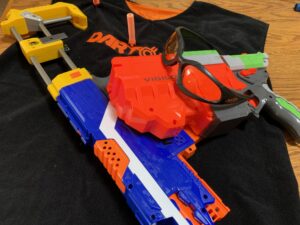Toys, games and the eyes: Tips to keep kids safe this holiday season
As we’re immersed in the season of toy buying, here are a few safety tips to keep in mind. These guidelines are not absolute; the best toy for a child also takes into account their individual interests, abilities and level of responsibility.
According to the U.S. Consumer Product Safety Commission, there were an estimated 226,100 toy-related injuries treated in hospital emergency departments in 2018. Forty-six percent of the estimated injuries were to the head and face area, the most commonly affected area of the body.
Some propelling toys, such as airsoft guns, arrows, paintball guns and darts, can be particularly hazardous, with the potential to cause serious eye injuries including scratching the surface of the eye, bleeding inside the eye, traumatic cataract, increased eye pressure and even permanent vision loss. It’s best to avoid purchasing projectile-firing toys due to safety concerns. However, if your children are playing with these types of toys, everyone, even adults, should follow/wear the recommended protection, including eye protection, to block flying objects from damaging their eyes.
An estimated 17 percent of children’s eye injuries are caused by missile-type toys or toys with hard edges or detachable parts. Look for toys marked with “ASTM”, which means the product meets the national safety standards set by the American Society for Testing and Materials. Do not allow your children to play with non-powder rifles, pellet or BB guns. They are extremely dangerous and have been reclassified as firearms and removed from toy departments.
Youngsters are particularly vulnerable during the excitement of the holidays. The Illinois Society for the Prevention of Blindness offers the following recommendations:
1. Be aware of how and where your children or grandchildren play with their toys. There is no substitute for adult supervision.
2. Keep inappropriate toys away from children who are too young or too inexperienced to use them properly.
3. Make sure toys will not shatter with rough handling or under violent impact.
4. Read manufacturers’ instructions for using toys properly and age appropriateness.
5. Ensure that laser-product labels include a statement that the device complies with 21 CFR (the Code of Federal Regulations) Subchapter J.
Babies like toys that stimulate their senses, especially those that are brightly colored and lightweight for handling. They should not have sharp edges, points, or pieces that can be swallowed. Everything should be made of non-toxic materials. Floating bath toys and stacking toys are always favorites.
Toddlers need toys for active play, such as balls or a wagon. Blocks and simple puzzles are good at this age, as are picture books.
Preschoolers like to use their imaginations. Dolls, teddy bears, toy telephones, planes, cars and boats are all appropriate, here. Larger outdoor toys such as a swing set or tricycle encourage balance and fitness. Board games, word and matching games, construction sets, modeling clay and other art supplies help with visualization and memory skills. Books are always appreciated, especially if someone reads along with them.
School-age kids ride bicycles (with helmets!), roller skate, jump rope and play sports. Don’t forget that sports equipment, a popular gift, also should include protective eyewear. Nearly 30,000 sports-related eye injuries are treated in U.S. emergency rooms annually. Science, modeling and craft kits encourage experimentation and fine motor skills. Board games, table-top sports games, doll houses, racing cars and electric trains also help kids develop skills for social and solitary play.
Video games are a mixed blessing. On the down side, staring at a video screen can dry out eyes and cause blurring, itching and burning. Headaches (both in players and parents) and other symptoms of eyestrain also can occur. There is growing concern among the eye health community about the increased cases of myopia (nearsightedness) in children. Both genetics and environmental factors play key roles in myopia. But the recent, dramatic upswing in cases appears to be driven by environmental factors. People are spending less time outdoors and more time on near-work activities such as screen time and reading. Kids who develop myopia early in life and progress to high myopia have a 50 percent greater risk of glaucoma, they are 17 percent more likely to need cataract surgery, and have a 6 times greater risk of retinal detachment and retinal tears. On the positive side, video games in moderation may help with eye-hand coordination, and some may be educational.
One final note: If you have been around on Christmas morning you know that more than a few young children are more interested in the wrapping paper and boxes than presents. Be careful, as these can be dangerous play things.
Keep it simple, and have a safe and happy holiday.
The material contained in this article is for informational purposes only and is not intended to be a substitute for professional medical advice, diagnosis or treatment. Always seek the advice of your physician or other qualified health care provider.
BIO: Dr. William Benevento is a board-certified ophthalmologist. He has special interests in diabetes and cataracts. He practices at Eye Surgeons Associates in Bettendorf. For more information, visit esaeyecare.com.





